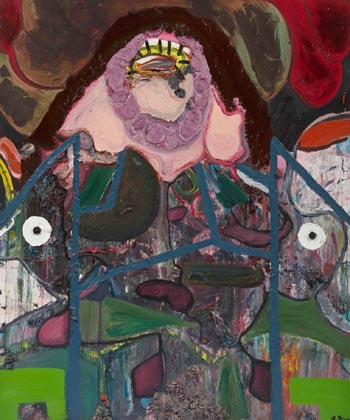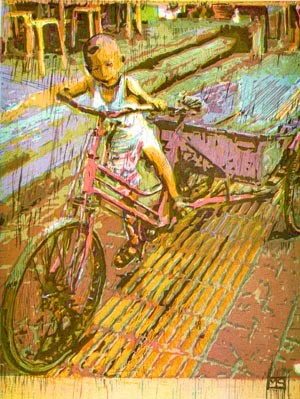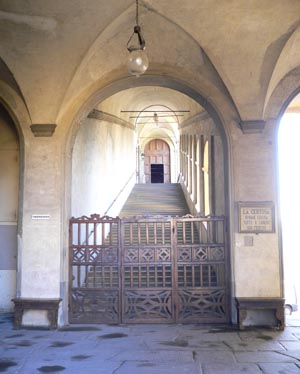
by Christina Waters | Aug 18, 2010 | Art, Home |
A recent graduate of UCLA’s renowned MFA program, Ian Pines continues to explore the  wickedly inventive color work and lavishly gestural oil paintings he began while still an art major at UCSC. Here’s a sample of Pines’ highly original abstract style, played out in large-scale (e.g. 6 x 8 foot) canvases, and a brief interview with the Los Angeles-based artist.
wickedly inventive color work and lavishly gestural oil paintings he began while still an art major at UCSC. Here’s a sample of Pines’ highly original abstract style, played out in large-scale (e.g. 6 x 8 foot) canvases, and a brief interview with the Los Angeles-based artist.
Q: Ian—your abstract paintings remind me of Philip Guston by way of Willem de Kooning. Are you aware of any particular influences in your style?
A: That’s quite the apt observation. Like de Kooning, there are bombastic color choices forcefully yet thoughtfully laid on top of each other to make homely, sad, and whimsical forms similar to Guston’s.
Francis Bacon’s witty horror, stylized violence, and macabre non-sequiturs have always been my favorite. The immediacy of his work is something I strive for. I compare my work with the COBRA movement’s (based in Copenhagen, Brussels, Amsterdam which included such artists as Karel Appel and Asger Jorn) uses of abstract expressionism in the construction of figurative forms. I am also influenced by Carroll Dunham’s work, especially of the 1990s, which places teeth and genitalia on abstract forms in order to dramatically and instantaneously anthropomorphize them. Eyes and teeth added to my compositions significantly help unify my paintings and give them a more contemporary twist.
Q: How did your MFA work at UCLA help you develop your creative instincts?
A: UCLA nurtured my creativity by channeling it into a certain rhythm (more…)
by Christina Waters | Aug 11, 2010 | Art, Home |
Maybe it’s just me, and if so, then you can ignore this observation. But I’m beginning to think that contemporary, especially young audiences have no idea how to respond to live theater. The serious kind, as in Shakespeare.
Worse. It’s entirely possible, at least based upon what I’ve seen lately, that actors and directors themselves are drifting away from creating coherent contexts for the spectacles they mount. Let me speak plainly: given postmodernism’s trashing of history, historical background and/or consideration for any and all authorship, the state of English-language theater seems to be suffering from serious identity issues.
Audiences raised on screen-mediated ‘entertainment’ are little inclined to suspend disbelief (more…)

by Christina Waters | Jul 26, 2010 | Art, Home |
Q: Max, your color woodblock “Untitled,†(Bike) is a knockout – how did you achieve the amazing effects?
amazing effects?
A: Untitled, 9×12, was a seven run print, five separate woodblocks with two reduced states one on the second and one on the fourth in the print sequence; edition of 15. The final number of colors in the piece I roughly estimate to be around 40, maybe more. This was achieved by applying CMYK color separation technology to a photographic source and then separating each channel into a duotone of that color except for the key layer. This information was then hand copied and carved out of Japanese shina wood and printed in hand-mixed oil-based inks in sequence.
Q: Where did you develop your skill with multiple woodblocks?
A: I developed my skill with multiple woodblocks primarily under the guidance and motivational support of UCSC Lecturer Paul Rangell. Richard Wohlfeiler, another UCSC teacher also played a large role in opening my mind to the possibilities of the medium, and gave me the technical support needed to realize the completion of the seemingly impossible projects I had imagined.
I spent a great deal of time in mainland China (more…)

by Christina Waters | Jul 5, 2010 | Art, Home |
 A suite of vibrant paintings in various media by Kit Eastman, is on display through August at the intimate (i.e. tiny) Eduardo Carrillo Gallery. Eastman, a UCSC alumna, works in expressive layers of impasto loaded with gesture, color and the invisible presence of Bay Area figurative masters such as Nathan Oliviera and Elmer Bischoff.
A suite of vibrant paintings in various media by Kit Eastman, is on display through August at the intimate (i.e. tiny) Eduardo Carrillo Gallery. Eastman, a UCSC alumna, works in expressive layers of impasto loaded with gesture, color and the invisible presence of Bay Area figurative masters such as Nathan Oliviera and Elmer Bischoff.
Strolling (shown here) is one of a pair of tiny oils which join a dozen larger-scale figurative studies of nudes embedded with cyanotype x-rays. The series plays with the idea of “stripping bare” the figure in which the interior skeletal anatomy both reveals, and conceals, a voluptuous bodily surface.
The Carrillo Gallery is located within the Baskin Arts Complex, just above the new Digital Arts Research Center, on the UCSC Campus. The gallery is open Mon-Fri, 9-5 all summer long.
by Christina Waters | Jun 19, 2010 | Art, Home |
Last week my great girlfriend Laurel and I headed over to Bandar Persian Restaurant in the bustling Friday night heart of old San Diego for a terrific and authentic meal of middle eastern flavors.
Our starter, an eggplant appetizer slow roasted with fresh garlic and onion topped with homemade yogurt, was blatantly addictive. We sprinkled plenty of dried sumac on top and enjoyed every single bite, along with soft lavosh. I adore sumac, that lemony, sour condiment that somehow jumpstarts every dish in the Persian repertoire.
A stew of spring baby lamb shank – buttery and delicious, slow-cooked with red beans, lime and herbs – was intensely rich and pungent. As was the mountain of saffron rice that accompanied my dish.
Ditto my companion’s order of ground filet mignon (more…)

by Christina Waters | Jun 1, 2010 | Art, Food |
The Certosa di Galuzzo is an enormous cloister dating from the 1300s located  about three miles up into the hills above Florence. In other words, it is situated on one of those stereotypically picturesque Tuscan hillsides dotted with tall black Lombardy cypresses and lots of villas with red tile roofs. Mustard and bougainvilla was in bloom everywhere, quinces falling from the trees and the vineyards were a minute away from harvest.
about three miles up into the hills above Florence. In other words, it is situated on one of those stereotypically picturesque Tuscan hillsides dotted with tall black Lombardy cypresses and lots of villas with red tile roofs. Mustard and bougainvilla was in bloom everywhere, quinces falling from the trees and the vineyards were a minute away from harvest.
We took a cab up to the huge stately compound, and the bus back into town a few hours later. In between we joined a tour, along with seven other people, through the opulent chapel, private cells of the Cistercians who still live and work there, and saw the magnificent, faded frescoes made by Pontormo during the plague years in the 16th century. They were astonishingly original – so utterly unlike any of the work done during the same time by Pontormo’s colleagues that they appeared as modern as they were idiosyncratic. Back out into the sunlight, we stopped at the certosa’s distillary shop to purchase some of the liqueurs made by the brothers – including an herb-laced fernet I can’t wait to try.
 Wandering over toward the Palazzo Strozzi after our return, we decided to try a new wine bar that served us one of the best pizzas of our lives. It’s called Bussola, and they served us a pizza topped with pecorino, cherry tomatoes and wild boar sausage along with a huge glass of Chianti Classico from the surrounding hills, vintage 2006. The pizza had that very thin, crisp crust — no tomato sauce, no gooey mozzarella — that distinguishes northern Italian pizza. Absolutely outrageous – and perfect for a light lunch for two.
Wandering over toward the Palazzo Strozzi after our return, we decided to try a new wine bar that served us one of the best pizzas of our lives. It’s called Bussola, and they served us a pizza topped with pecorino, cherry tomatoes and wild boar sausage along with a huge glass of Chianti Classico from the surrounding hills, vintage 2006. The pizza had that very thin, crisp crust — no tomato sauce, no gooey mozzarella — that distinguishes northern Italian pizza. Absolutely outrageous – and perfect for a light lunch for two.

 wickedly inventive color work and lavishly gestural oil paintings he began while still an art major at UCSC. Here’s a sample of Pines’ highly original abstract style, played out in large-scale (e.g. 6 x 8 foot) canvases, and a brief interview with the Los Angeles-based artist.
wickedly inventive color work and lavishly gestural oil paintings he began while still an art major at UCSC. Here’s a sample of Pines’ highly original abstract style, played out in large-scale (e.g. 6 x 8 foot) canvases, and a brief interview with the Los Angeles-based artist.



 Wandering over toward the Palazzo Strozzi after our return, we decided to try a new wine bar that served us one of the best pizzas of our lives. It’s called Bussola, and they served us a pizza topped with pecorino, cherry tomatoes and wild boar sausage along with a huge glass of Chianti Classico from the surrounding hills, vintage 2006. The pizza had that very thin, crisp crust — no tomato sauce, no gooey mozzarella — that distinguishes northern Italian pizza. Absolutely outrageous – and perfect for a light lunch for two.
Wandering over toward the Palazzo Strozzi after our return, we decided to try a new wine bar that served us one of the best pizzas of our lives. It’s called Bussola, and they served us a pizza topped with pecorino, cherry tomatoes and wild boar sausage along with a huge glass of Chianti Classico from the surrounding hills, vintage 2006. The pizza had that very thin, crisp crust — no tomato sauce, no gooey mozzarella — that distinguishes northern Italian pizza. Absolutely outrageous – and perfect for a light lunch for two.